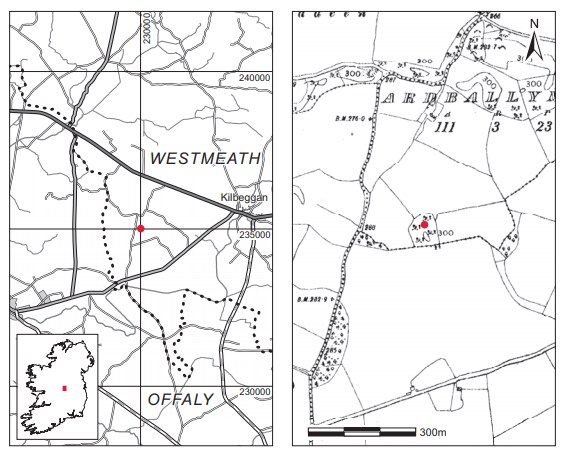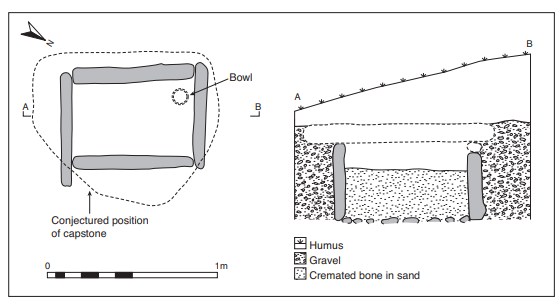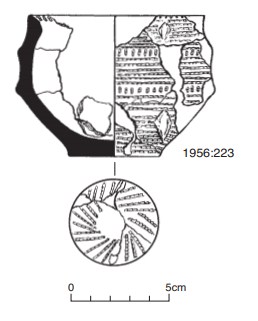County: Westmeath Site name: ARDBALLYMORE, CO. WESTMEATH
Sites and Monuments Record No.: SMR WM037-009 Licence number: E1161
Author: JOSEPH RAFTERY
Site type: Early Bronze Age graves
Period/Dating: —
ITM: E 629961m, N 735040m
Latitude, Longitude (decimal degrees): 53.364714, -7.549848
Introduction
In August 1956 a short cist containing a cremation and a vessel was discovered during field clearance near Kilbeggan, Co. Westmeath. The work was being carried out on behalf of the Land Rehabilitation Project, and the capstone was broken into small pieces with a sledgehammer before it was recognised as a cist.312 The contents were completely cleared out by the workers. The discovery was reported to the Gardaí at Kilbeggan, who took possession of the bones and informed the NMI. The site was investigated by Dr Joseph Raftery and the human remains were examined by Laureen Buckley.
Location (Fig. 3.173)
The site was in the townland of Ardballymore, south Co. Westmeath.313 It was on the top of a small gravel hillock, approximately 90m above sea level. The cist was located only 500m south-west of another in Kilgaroan townland which had been excavated the previous month by Ellen Prendergast (this volume, pp 513–16).
Description of site
The grave consisted of a short cist, rectangular in plan, with its long axis aligned northwest/south-east. It measured 0.71m long by 0.45m wide by 0.45m high (Fig. 3.174). The cist was formed of four main side slabs set on edge, with one slab at each side. These slabs were regular in shape, with a maximum length of 0.71m and a maximum thickness of 0.1m, with that at the south-eastern end extending some 0.1m beyond the edge of the cist. The northwestern end stone was some 0.07m shorter than that at the south-eastern end and was probably added to by a small ‘padstone’ so that the capstone would rest level on the walls. The cist walls do not appear to have been supported by packing stones. The capstone was smashed into three pieces before the excavation, but according to the plan it was subcircular and measured approximately 1.05m long by 0.9m across by 0.11m thick.


The floor of the cist was not paved but a number of small stones appear to have been placed on the floor. The pit dug to receive the cist is referred to but measurements were not provided.
The cist contained the cremated remains of an adult male and an adolescent or juvenile (1956:224), and sherds of a tripartite bowl. According to the finders, the cist was almost completely filled with sand. The cremated bones were apparently scattered throughout this sand and not concentrated in one particular area. The sherds of the bowl that were discovered at the time of Raftery’s inspection lay in the north-western end of the cist, towards the centre of the wall.
Tripartite bowl, 1956:223 (Fig. 3.175)
Only the base and a quarter of the body of the vessel have survived. It is decorated with lightly impressed arcs and with rows of comb impressions (Ó Ríordáin and Waddell 1993, 139). The base was about 4.9cm in diameter and decorated with comb impressions forming a sun-ray Pattern.

Comment
A sample of the cremation was submitted for AMS dating and yielded a date of 3695±40 BP, which calibrates to 2200–1950 BC at 95.4% probability.314 Brindley (2007, 173, 242) has placed the vessel in stage 1 of the development of bowl tradition pottery, which is dated to 2160–2080 BC.
HUMAN REMAINS
LAUREEN BUCKLEY
Introduction
Sample 1956:224 consisted of 687 fragments of cremated bone, weighing a total of 790g. The bone was slightly discoloured with soil but it was mostly a creamy white colour, with only a few blue fragments. Most of the bones were warped and had numerous horizontal fissures.The weight of bone recovered is quite high, considering that the cremation had been disturbed and fragments were collected by the Gardaí. It suggests that there had been at least one full adult cremation in the cist originally.
Table 3.107—Fragmentation of bone, 1956:224.

The fragmentation of the sample is shown in Table 3.107, with the largest fragment being 100mm. It can be seen that there was a significant proportion of very large fragments and that most of the sample is made up of large fragments more than 15mm in length. Very few small fragments were present. This is to be expected from the way the bone was collected. It is understandable that the more visible and recognisable larger fragments would be collected by non-archaeologists, and it was probably thought that the smaller fragments were of no value. Nevertheless, considering that it is a relatively large sample, it is highly likely that the original cremation consisted of mainly larger fragments and was not deliberately crushed before being interred.
Identifiable bone
The lack of crushing of the bone is reflected in the amount that could be identified (Table 3.108). A total of 582g (74% of the total bone) was identified.
Table 3.108—Proportion of identified bone, 1956:224.

Table 3.109—Summary of identified bone, 1956:224.

Table 3.109 summarises the main parts of the skeleton identified. It can be seen that the skull is overrepresented in this sample, as the proportion of skull is twice what it should be. The axial skeleton is only half of what it should be. This is not surprising, as the vertebrae and ribs are very light, fragile bones that would break easily on disturbance; the small fragments would not look like real bone and therefore would not be picked up. The quantities of upper limb and lower limb bones, however, were almost exactly what they should have been.
Description of identifiable features of the bones
Skull
Fragments included a portion of the squamous part of the frontal bone with the metopic suture. There were also fragments of the internal surface of two frontal bones, from near the glabella with the crista frontalis visible. One left orbit was present and the absence of supraorbital ridges suggests that it was from a female or an adolescent.
There were several large fragments of parietal bone, and one had a parietal foramen. The maximum thickness of the parietal bone was 9.5mm.
Two large fragments of the squamous part of the occipital bone from two individuals were present. In one the external occipital protuberance was pronounced.
Part of the mastoid area of temporal bone was present but the mastoid process was missing. There was also a small part of the petrous portion of a temporal bone. The left temporal fossa and part of one other temporal fossa were present.
Mandible and maxilla
The right side of the body was present; it was split through the alveolus but some tooth sockets were visible. There were also three tooth fragments that seemed to be the roots of permanent incisors.
Part of the left side of the maxilla was present, and there were the roots of a third molar and of a premolar.
Dentition
The following tooth sockets were present:

Mandibular tori were present in the mandible.
Vertebrae
The left and right sides of the neural arch and the dens area of the first cervical vertebra were present. The left side of the second cervical vertebra was present, as well as one body and a few articular surfaces from the lower cervical vertebrae.
One thoracic body and a few articular surfaces were present, and there were a few articular surfaces from the lumbar vertebrae.
The body and part of the ala of the first sacral vertebra was present. There was also the body of the second sacral vertebra.
Ribs
Several rib fragments were present; some were large and some were very small.
Pelvis
Most fragments were of ilium but there was also one large fragment of acetabulum, although it could not be said whether it was fused or not.
Scapulae
Part of the right acromial spine and a lateral border were present. There were two left glenoid fossae and acromial spines.
Humerus
The proximal third of the left humerus with the metaphyseal surface was present. The epiphysis was unfused. There were several fragments of proximal and distal shaft, including the distal end of a right bone with most of the trochlea present. The distal epiphysis was fused, including the medial condyle. There was a smaller trochlea from another right humerus but it could not be certain whether or not it was fused to the shaft.
Radius
The proximal third of the shaft of a left radius with the metaphyseal surface visible was present, and there were also several fragments of middle and lower shaft. The distal end of a radius with fused epiphysis was also present.
Ulna
There were several fragments from both the proximal and distal halves of shaft, including one fragment from near the proximal joint surface. There were no joint ends visible.
Metacarpals and phalanges
There was one almost complete metacarpal shaft and fragments of at least two others, as well as one proximal, two middle and two distal hand phalanges.
Femur
The proximal ends of two femurs with the metaphyseal surfaces for the head, the neck and part of the proximal shafts were present. Several fragments of the shaft were present; some were very thick and definitely from an adult and some were from a juvenile. Three fragments of distal joint surfaces were present, but there was no evidence as to whether or not they were fused.
Tibia
The proximal joint surface with the epiphysis unfused was present, and there were fragments from the distal joint end. There were several other fragments of shaft with the anterior and interosseous borders present.
Fibula
This consisted of fragments of shaft only.
Tarsals/metatarsals
A fragment of calcaneum, a fragment of talus and a fragment of navicular were present. There were also two metatarsal shafts and small fragments of other tarsal bones.
Minimum number of individuals
There appear to be two individuals present. One seems to be an adult, possibly a male, and the other is an older juvenile or adolescent.
One unidentified fragment that could have been an infant long bone or from a small animal was also found.
Summary and conclusions
This sample consisted of 790g of efficiently cremated bone, which, although it does not represent the amount of bone available from a full cremation, is a sizeable quantity and indicates that the amount of bone present before the cist was disturbed must have been quite large. Most of the sample consisted of large fragments, and although this might be because non-archaeologists collected the bone and would have tended to pick up the larger fragments, it is probably an indication that there was a high proportion of larger fragments in the original sample. This means that it is unlikely that the cremation was deliberately crushed as part of the cremation ritual.
A large proportion (74%) of the bone was identified and all parts of the skeleton were represented, although there was a small amount of axial skeleton collected. The cremation contained the remains of two individuals, an adult male and an older juvenile or adolescent.
312. It was thought to have been a natural outcrop.
313. Parish of Ardnurcher or Horseleap, barony of Kilbeggan. SMR WM037-009——. IGR 230017 235014.
314. GrA-24175.